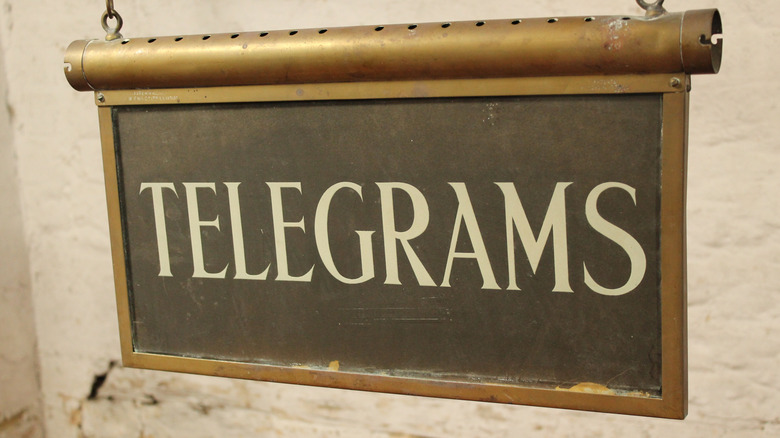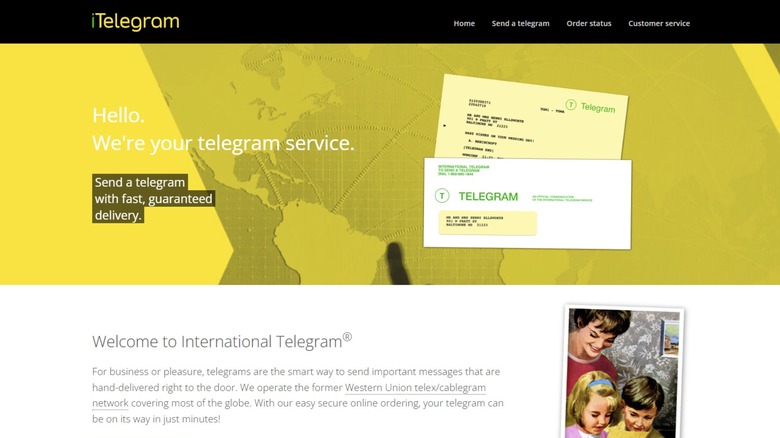Yes, You Can Still Send A Telegram In The US (And Here's Why You Might Need To)
While many people associate the word "telegram" with the Telegram messenger app that is known for its end-to-end encryption, some older users of the internet may remember what its name was based on. Telegrams, which are messages sent via wire or electric telegraph, have been around since the 1800s. While there is conflicting information about who invented electric telegraphy, Samuel Morse (who is also known for developing Morse code) is widely credited for the system that made it work on a large scale in the United States. Apart from connecting people, businesses, and governments, telegrams have played important roles in railroad control and relaying key information during conflicts such as the American Civil War. By 1866, reliable cross-Atlantic telegraphy became a reality.
These days, telegrams have been mostly cast to the side — first in favor of fax machines and text messages, and, more recently, emails and instant messaging apps. That said, the humble telegram still has a place in many people's hearts, especially in an age where other analog experiences like vinyl records are making a comeback. While it's not the most efficient way to communicate, sending telegrams can be another way to resist the modern obsession with efficiency. In an age where getting seen-zoned or ghosted is a rite of passage, telegrams are tangible proof that we care enough about people to be inconvenienced. But they also have other uses, including in legal contexts.
Why you might want to try sending telegrams
Even in modern times, telegrams are still considered legally recognized documents. For this reason, they can be used in court as timestamped, official documents for written notices and contract cancellations. That said, you may need to pay extra for a legally certified copy. However, this isn't the only reason people still send telegrams.
Even in modern times, telegrams play a culturally significant role in some countries. In Japan, for example, telegrams are seen as a respectful way of communication. For an aging population that still recalls the heyday of the telegram, it is seen as an important component of formal salutations for everything from business interactions, weddings, funerals, promotions, to other big life moments. Some telegram services also offer the option to have someone read them out loud via a phone operator, which is a godsend for aging recipients or anyone else who struggles to read text. Not to mention, it may also be a less impersonal way to deliver sensitive news.
That said, you can send your first telegram for no reason other than to have an oddly specific life experience that you can share as a fun fact about yourself. Western Union axed its long-running telegram service in 2006, but iTelegram has taken up its mantle and network. With iTelegram, you can send telegrams to multiple countries, including the United States. Here's how you can try it for yourself, how much it costs, and other services it offers.
How to send telegrams in the US today
On the iTelegram website, click "Send a Telegram" on the homepage. Next, you'll need to type recipient details like their name, company name (if applicable), address, and telephone number. Next, you can write out your message and agree to the terms and conditions. Lastly, you can review the telegram and select your preferred delivery method.
On the website, iTelegram offers two delivery options: Mailgram and First Class Priority Telegram. For $18.95, the more affordable Mailgram option lets you send up to a hundred words within three to five business days. Although it is cheaper, it's important to note that it doesn't let you choose the delivery date or provide additional benefits. To manage your expectations, though, reporters attempted to send a telegram using this service in 2016 and noted that it took more than 40 days to reach their destination.
On the other hand, the First Class Telegram option is significantly more expensive at $34 plus $0.75 per word. Unlike the other option, iTelegram claims it can send a First Class Telegram within 24 hours on weekdays, with options for weekend deliveries for places like hospitals and funeral homes. Beyond the telegram itself, the First Class Telegram service includes a free PhoneGram message, where an operator will read the telegram out loud to the recipient over the phone. You can also request a signature and provide legal proof of delivery.


